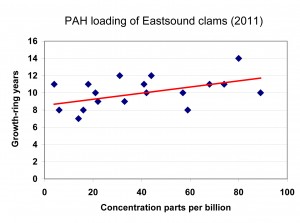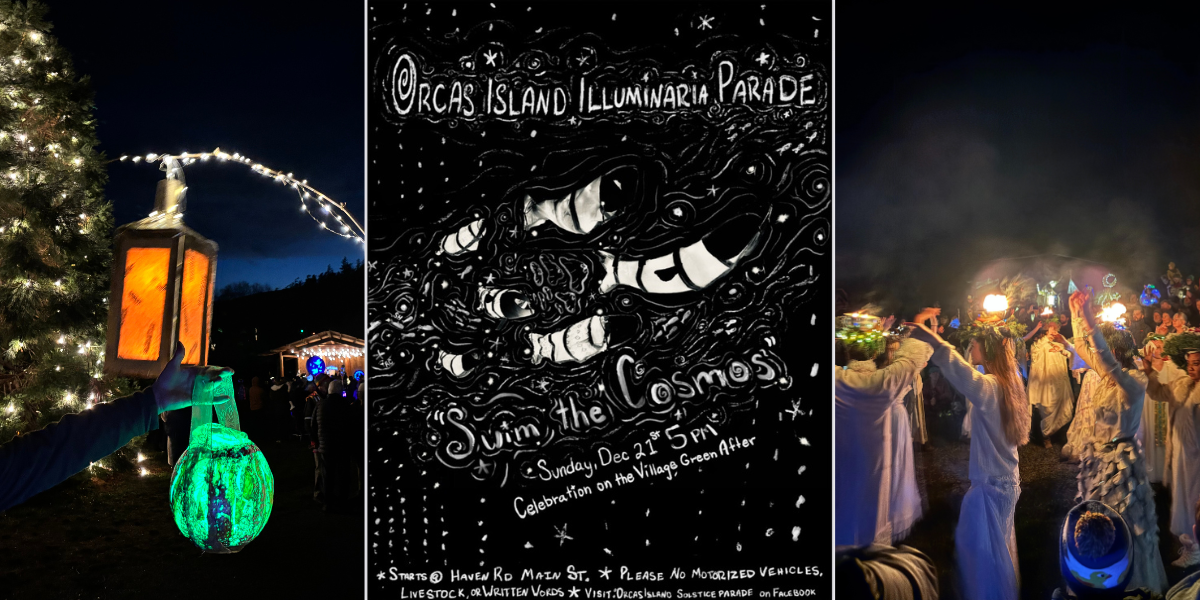Contributed by Russel Barsh

For background information on this graph, developed by Middle School Science Club, contact Russel Barsh at RLBarsh@gmail.com
Members of the Middle School Science Club have measured the amount of Polycyclic Aromatic Hydrocarbons (PAHs) in clams dug last summer from the beach at Eastsound, below the storm sewer outfall. Working under the direction of Kwiáht director Russel Barsh, students extracted fat-soluble compounds from frozen clam muscles, and used antibodies to detect and measure the amount of PAHs in the extracts.
On average, the Eastsound clams contained 37 parts per billion of PAHs. That is equivalent to about a teaspoonful of PAHs in ten tons of clam meat. But PAHs such as Benzo-alpha-Pyrene (BaP) are so carcinogenic, that the US EPA maximum allowable concentration in drinking water is 200 parts per billion—and
any measurable concentration in food or water is regarded as a health issue.
The concentration of PAHs in Eastsound clams increased slightly with age, meaning that there is some bioaccumulation of PAHs over time. Individual clams varied a great deal, however, consistent with studies carried out elsewhere.
A positive control was used to check the accuracy of students’ work. They measured it to within 4 percent of its factory-certified concentration.
BaP and other PAHs come mainly from fossil fuels including gasoline and diesel oil, motor oil, and motor vehicle exhaust. PAHs from motor vehicle engine leakage and exhaust stick to silt and dust on roads, and when it rains, wash into storm sewers and into the bay. The Eastsound constructed wetland is designed to remedy this threat to local marine life and seafood safety. PAH levels in clams should decrease over the next five to 10 years.
The Orcas Middle School Science Club is devoted to engaging students in technically challenging conservation research, such as evaluating bioremediation and habitat-restoration projects so that we can learn how to improve future ones.
This year, the Club is coordinating with Laura Tidwell’s classes, which are learning about the design of bioremedial systems from Kwiáht architect Nathan Hodges. Classes are building scale models, and Science Club members will test the models for efficacy against different kinds of contaminants.
This year’s Club members are Holden and Liam Griskey, Nathan Vekved, and Desmond Graves.
Letters of interest from other Orcas Grades 6-9 students are welcome: write to kwiaht@gmail.com.
For background information on the graph pictured above, the underlying data, and how it was derived, contact Russel Barsh at RLBarsh@gmail.com.
**If you are reading theOrcasonian for free, thank your fellow islanders. If you would like to support theOrcasonian CLICK HERE to set your modestly-priced, voluntary subscription. Otherwise, no worries; we’re happy to share with you.**








Great work students and adults! Establishing a baseline before the mitigating wetland (completed)project is important. I would hope a longitudinal study of the PAH levels in the same clam population and the efficacy (or not) of the wetland can continue with the science club.